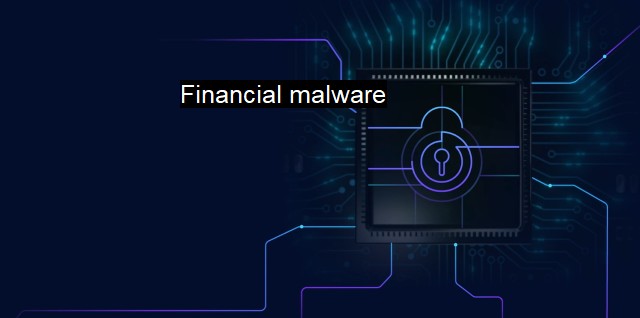What is Financial malware?
Protecting your Finances: Understanding and Combating Financial Malware with Antivirus Programs
Financial malware refers to malicious software used to conduct illegal activities involving finance and monetary channels. Such activities broadly comprise stealing banking details, unauthorized fund transfers, interrupting online transactions, and manipulations in financial operations.In cybercriminal terminology, financial malware is designed specifically to attack financial systems. The cyber-robbers can intrude on digital transactions, swipe critical information about bank accounts, and clandestinely siphon off funds. What renders it particularly perilous is its capability to stay concealed long enough to commit substantial financial theft before being detected.
From a broader viewpoint, financial malware isn't a specific entity per se, but rather a category encompassing different types of sinister software programs, such as ransomware, spyware, Trojan horses, and viruses. All these malicious deployments, known as the threatscape, possess unique characteristics with the common objective of exploiting vulnerabilities in the financial structure for wrongful gains.
Financial malware attacks have exponentially evolved. Earlier, malware was generated to cause disruption or vandalize, merely wreaking havoc on the targeted systems. But lately, the primary objective has shifted to monetary gain, highlighting the rise in a spate of financially motivated breaches exponentially.
Understanding how financial malware works is detrimental to devising effective countermeasures. Hackers typically use different channels, from contagious download links, corrupted email attachments, malicious third-party apps, or infected web pages, to deliver such malware to a user’s computer or device.
Once the malware infiltrates successfully, it can sit dormant or commence its malicious drive immediately. It can either monitor the user's actions, particularly those related to financial transactions, or deploy tactical techniques such as keylogging to underhandedly procure username, password, and other critical banking details. Sophisticated types of financial malware can even create dummy web pages or false login screens to mislead users into voluntarily submitting their crucial details, assuming they are communicating to their bank's legitimate site.
In the arena of antivirus protection and cybersecurity, experts focus primarily on financial malware due to their devastating implications. Effective countermeasures encompass two main theatres of action: the prevention and detection of such malware, and the damage control post-infection.
The antivirus programs are designed to respond to such cyber threats. They are consistently on the watch and are engineered using sophisticated algorithms to identify all potential malware threats. Upon detection, these antivirus tools isolate and annihilate such threats before they inflict damages.
Another vanguard line of cybersecurity is teaching about safe internet practices and the significance of regular software updates, and anti-virus scans to individuals and organizations. These security practices serve as a safeguard to the system’s overall security, curtailing the probability of cyber breach attempts.
Despite its advanced arsenal of detection and removal of such sensitive threats, the realm of cybersecurity isn't bulletproof yet. Given the tremendous growth in online financial transactions, the enormity of these virtual menaces will rise proportionately. Cybersecurity teams constantly need to evolve their defensive capabilities in line with the mutating threats thereby reinforcing the chant, "The price of freedom is eternal vigilance," in the financial cyber world.
Conclusively, financial malware, while not a tangible demon, poses significant threats to digital financial operations, capable of annulling banking security, pilfering vast sums, and leaving financial structures in disarray. The collective effort of cybersecurity measures, including various antivirus tools, serves as our line of defense, underlining their significance in the digital era. As we expedite the shift from material currency to digital transactions, our preparedness level in tackling financial malware menaces should be nothing short of sophisticated.

Financial malware FAQs
What is financial malware?
Financial malware is a type of malicious software designed to steal financial information, such as bank account numbers, credit card details, and login credentials, from the victim's computer or mobile device.How does financial malware work?
Financial malware typically infects a target system through phishing emails, malicious attachments, or infected websites. Once installed, the malware can monitor the victim's online activities and intercept sensitive information, which is then transmitted to the attacker's command and control server.What are the consequences of financial malware attacks?
The consequences of financial malware attacks can be severe and long-lasting. Victims may lose money, have their credit cards and bank accounts compromised, and suffer damage to their credit standing. Moreover, financial malware can also enable attackers to take over a victim's computer, steal personal data, and use it for further fraudulent activities.How can individuals and businesses protect themselves from financial malware attacks?
There are several ways to protect against financial malware attacks. Individuals and businesses should use up-to-date antivirus software, avoid clicking on suspicious links or opening unknown attachments, and regularly update their operating systems and applications. Additionally, it is advisable to use two-factor authentication and strong passwords, and to monitor bank accounts and credit reports for any signs of suspicious activity.| | A | | | B | | | C | | | D | | | E | | | F | | | G | | | H | | | I | | | J | | | K | | | L | | | M | |
| | N | | | O | | | P | | | Q | | | R | | | S | | | T | | | U | | | V | | | W | | | X | | | Y | | | Z | |
| | 1 | | | 2 | | | 3 | | | 4 | | | 7 | | | 8 | | |||||||